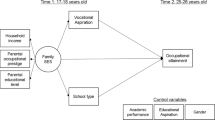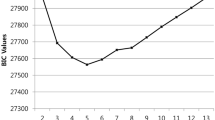Abstract
The purpose of this longitudinal study is to examine the effects of personal factors and contextual determinants on the career maturity change of Korean adolescents over a 5-year period. This study used data from the Korea Youth Panel Survey which was administered to 3,449 junior high students from Grades 8 to 12, starting in 2003. A linear mixed-effects regression was used to test the study model. The results showed the levels of Korean adolescents’ career maturity were significantly influenced by personal predictors (gender, work values, career efficacy, self-efficacy, career development activities, school achievement, sex-role stereotyping, pressure for academic achievement, and part-time experiences) and contextual predictors (career conversations with parents, relationships with friends, and private education expense). Among career-related variables, only work values affected the slope of the career maturity growth curve. Implications for career counselors and educators are discussed.

Similar content being viewed by others
References
Abu-Hilal, M. M. (2000). A structural model of attitudes toward school subjects, academic aspirations, and achievement. Educational Psychology, 20, 75–84. doi:10.1080/014434100110399.
Achebe, C. C. (1982). Assessing the vocational maturity of students in the east central state of Nigeria. Journal of Vocational Behavior, 20, 153–161. doi:10.1016/0001-8791(82)90003-3.
Alvi, S. A., & Khan, S. B. (1983). An investigation into the construct validity of Crites’ career maturity model. Journal of Vocational Behavior, 22, 174–181. doi:10.1016/0001-8791(83)90026-X.
Armacost, R. L. (1989). Perceptions of stressors by high school students. Journal of Adolescent Research, 4, 443–461. doi:10.1177/074355488944004.
Bandura, A., Barbaranelli, C., Caprara, G. V., & Pastorelli, C. (2001). Self-efficacy beliefs as shapers of children’s aspirations and career trajectories. Child Development, 72, 187–206. doi:10.1111/1467-8624.00273.
Bates, D. (2005). Fitting linear mixed models in R. R News, 5, 27–30.
Bloor, D., & Brook, J. (1993). Career development of students pursuing higher education. New Zealand Journal of Educational Studies, 28, 57–68.
Blustein, D. L., Walbridge, M. M., Friedlander, M. L., & Palladino, D. E. (1991). Contributions of psychological separation and parental attachment to the career development process. Journal of Counseling Psychology, 38, 39–50. doi:10.1037/0022-0167.38.1.39.
Carns, A., Carns, M., Wooten, H., Jones, L., Paffield, P., & Heitkamp, J. (1995). Extracurricular activities: Are they beneficial? Texas Counseling Association Journal, 23, 37–45.
Cha, J. E., Kim, A. Y., Lea, E. K., & Kim, B. H. (2007). Gender difference and developmental trend in career maturity and career indecision among adolescents. The Korean Journal of Educational Psychology, 21, 923–944.
Choi, I. (2009). Korean survey on the career and occupation of youth in 2009. Seoul: National Youth Policy Institute.
Crites, J. O. (1965). Measurement of vocational maturity in adolescence: I: Attitude scale of the Vocational Development Inventory. Psychological Monographs, 79(2, Whole No. 595), 1–34.
Crites, J. O. (1978). Theory and research handbook for the Career Maturity Inventory (2nd ed.). Monterey, CA: CTB/McGraw-Hill.
Farmer, H. S. (1983). Career and homemaking plans for high school youth. Journal of Counseling Psychology, 30, 40–45. doi:10.1037/0022-0167.30.1.40.
Fouad, N. A. (1988). The construct of career maturity in the United States and Israel. Journal of Vocational Behavior, 32, 49–59. doi:10.1016/0001-8791(88)90005-X.
Garber, J., Keiley, M. K., & Martin, N. (2002). Developmental trajectories of adolescents’ depressive symptoms: Predictors of change. Journal of Consulting and Clinical Psychology, 70, 79–95. doi:10.1037/0022-006X.70.1.79.
Gottfredson, L. S. (2005). Applying Gottfredson’s theory of circumscription and compromise in career guidance and counseling. In S. D. Brown & R. W. Lent (Eds.), Career development and counseling: Putting theory and research to work (pp. 71–100). Hoboken, NJ: Wiley.
Harren, V. A. (1979). A model of career decision making for college students. Journal of Vocational Behavior, 14, 119–133. doi:10.1016/0001-8791(79)90065-4.
Hartung, P. J. (2010). Practice and research in career counseling and development—2009. The Career Development Quarterly, 59, 98–142. doi:10.1002/j.2161-0045.2010.tb00057.x.
Hartung, P. J., Porfeli, E. J., & Vondracek, F. W. (2005). Child vocational development: A review and reconsideration. Journal of Vocational Behavior, 66, 385–419. doi:10.1016/j.jvb.2004.05.006.
Hill, N. E., Ramirez, C., & Dumka, L. E. (2003). Early adolescents’ career aspirations: A qualitative study of perceived barriers and family support among low-income, ethnically diverse adolescents. Journal of Family Issues, 24, 934–959. doi:10.1177/0192513X03254517.
Jepsen, D. A., & Dickson, G. L. (2003). Continuity in life-span career development: Career exploration as a precursor to career establishment. The Career Development Quarterly, 51, 217–233. doi:10.1002/j.2161-0045.2003.tb00603.x.
Kablaoui, B. N., & Pautler, A. J. (1991). The effects of part-time work experience on high school students. Journal of Career Development, 17, 195–211. doi:10.1177/089484539101700305.
Keller, R. K., & Whiston, S. C. (2008). The role of parental influences on young adolescents’ career development. Journal of Career Assessment, 16, 198–217. doi:10.1177/1069072707313206.
Kim, S. R., & Lee, J. C. (2007). Influence of parent support, career decision-making self-efficacy and dysfunctional career thoughts on adolescent career maturity. Korean Journal of Counseling and Psychotherapy, 19, 393–407.
Korea National Statistical Office. (2008). Social indicators in 2008. Seoul: Korea National Statistical Office.
Korean Ministry of Education, Science, and Technology. (2009). Revised career guidance for middle school students. Seoul: Korean Ministry of Education, Science, and Technology.
Kracke, B. (1997). Parental behaviors and adolescents’ career exploration. The Career Development Quarterly, 45, 341–350. doi:10.1002/j.2161-0045.1997.tb00538.x.
Lee, K. H. (2001). A cross-cultural study of the career maturity of Korean and United States high school students. Journal of Career Development, 28, 43–57. doi:10.1177/089484530102800104.
Lee, K., & Yoon, M. (2011). The effect of parent factor, peer attachment and self-esteem on mature career choice in adolescents. Korean Journal of Family Welfare, 16, 175–199.
Lent, R. W., Brown, S. D., & Hackett, G. (1994). Toward a unifying social cognitive theory of career and academic interest, choice, and performance. Journal of Vocational Behavior, 45, 79–122. doi:10.1006/jvbe.1994.1027.
Lent, R. W., Brown, S. D., & Hackett, G. (2000). Contextual supports and barriers to career choice: A social cognitive analysis. Journal of Counseling Psychology, 47, 36–49. doi:10.1037/0022-0167.47.1.36.
Leong, F. T. L. (1991). Career development attributes and occupational values of Asian American and White American college students. The Career Development Quarterly, 39, 221–230. doi:10.1002/j.2161-0045.1991.tb00394.x.
Leong, F. T. L. (2010). A cultural formulation approach to career assessment and career counseling: Guest editor’s introduction. Journal of Career Development, 37, 375–390. doi:10.1177/0894845310363708.
Leong, F. T. L., Hardin, E. E., & Gupta, A. (2010). A cultural formulation approach to career assessment and career counseling with Asian American clients. Journal of Career Development, 37, 465–486. doi:10.1177/0894845310363808.
Levinson, E. M., Ohler, D. L., Caswell, S., & Kiewra, K. (1998). Six approaches to the assessment of career maturity. Journal of Counseling and Development, 76, 475–482. doi:10.1002/j.1556-6676.1998.tb02707.x.
Lim, E. (2009). Career guidance compared by types of vocational education among OECD countries. Korean Journal of Vocational Education & Training, 12, 1–20.
Lim, H. J., & You, J. M. (2007). The exploration of the effects of risk and protective factors on adolescents’ career uncertainty. Seoul: Korean Institute for Youth Development.
Lokan, J. J., Boss, M. W., & Patsula, P. J. (1982). A story of vocational maturity during adolescence and locus of control. Journal of Vocational Behavior, 20, 331–342. doi:10.1016/0001-8791(82)90020-3.
Long, J. D. (2012). Longitudinal data analysis for the behavioral sciences using R. Thousand Oaks, CA: Sage.
Luzzo, D. A. (1993). Value of career-decision-making self-efficacy in predicting career-decision-making attitudes and skills. Journal of Counseling Psychology, 40, 194–199. doi:10.1037/0022-0167.40.2.194.
Moracco, J. C. (1976). Vocational maturity of Arab and American high school students. Journal of Vocational Behavior, 8, 367–373. doi:10.1016/0001-8791(76)90052-X.
Miller, M. F. (1974). Relationship of vocational maturity to work values. Journal of Vocational Behavior, 5, 367–371.
Naidoo, A. V., Bowman, S. L., & Gerstein, L. H. (1998). Demographics, causality, work salience, and the career maturity of African-American students: A causal model. Journal of Vocational Behavior, 53, 15–27. doi:10.1006/jvbe.1997.1586.
National Youth Policy Institute. (2010). Korea youth panel survey. Seoul: National Youth Policy Institute.
Neely, M. A., & Johnson, C. W. (1981). The relationship of performance on six scales of the career development inventory to sex, father’s education, and father’s occupation. Educational and Psychological Measurement, 41, 917–921. doi:10.1177/001316448104100335.
Papalia, D. E., Olds, S. W., & Feldman, R. D. (1999). A child’s world: Infancy through adolescence. New York: McGraw Hill.
Park, M., & Lee, J. (2010). Testing the effects of person variables and school education on career maturity. Korean Journal of Human Understanding and Counseling, 31, 65–88.
Patton, W., & Creed, P. A. (2001). Developmental issues in career maturity and career decision status. The Career Development Quarterly, 49, 336–351. doi:10.1002/j.2161-0045.2001.tb00961.x.
Patton, W., & Lokan, J. (2001). Perspectives on Donald Super’s construct of career maturity. International Journal for Educational and Vocational Guidance, 1, 31–48.
Porfeli, E. J. (2007). Work values system development during adolescence. Journal of Vocational Behavior, 70, 42–60. doi:10.1016/j.jvb.2006.04.005.
R Development Core Team. (2008). R: A language and environment for statistical computing. R Foundation for Statistical Computing, Vienna, Austria. ISBN 3-900051-07-0, http://www.R-project.org/.
Rainey, M. L., & Borders, D. L. (1997). Influential factors in career orientation and career aspiration of early adolescent girls. Journal of Counseling Psychology, 44, 160–172. doi:10.1037/0022-0167.44.2.160.
Romano, J. L., Goh, M., & Wahl, K. H. (2005). School counseling in the United States: Implications for the Asia-Pacific region. Asia Pacific Education Review, 6, 111–121.
Rosenthal, D., & Hansen, J. (1981). The impact of maternal employment on children’s perceptions of parents and personal development. Sex Roles, 7, 593–598. doi:10.1007/BF00291746.
Ryu, S. (2005). An exploratory study of the relationship between adolescent part-time work experience and behavioral adjustments. Studies on Korean Youth, 41, 255–281.
Schultheiss, D., Kress, H., Manzi, A., & Glasscock, J. (2001). Relational influences in career development: A qualitative inquiry. The Counseling Psychologist, 29, 214–239. doi:10.1177/0011000001292003.
Super, D. E. (1963). The definition and measurement of early career behavior: A first formulation. Personnel and Guidance Journal, 41, 775–779.
Super, D. E. (1990). A life-span, life-space approach to career development. In D. Brown & L. Brooks (Eds.), Career choice and development: Applying contemporary theories to practice. San Francisco: Jossey-Bass Publishers.
Super, D. E. (1992). Toward a comprehensive theory of career development. In D. Montross & C. Shinkman (Eds.), Career development: Theory and practice (pp. 35–64). Springfield, IL: Charles C. Thomas.
Trusty, J., Robinson, C. R., Plata, M., & Ng, K. (2000). Effects of gender, SES, and early academic performance on post-secondary educational choice. Journal of Counseling and Development, 78, 463–472. doi:10.1002/j.1556-6676.2000.tb01930.x.
Van Schuur, W. H. (1997). Intrinsic and extrinsic work values as a single unfolding scale. In J. Rost & R. Langeheine (Eds.), Applications of latent trait and latent class models in the social sciences. New York: Waxmann Münster.
Vondracek, F. W., & Reitzle, M. (1998). The viability of career maturity: A developmental-contextual perspective. The Career Development Quarterly, 47, 6–15. doi:10.1002/j.2161-0045.1998.tb00724.x.
Watson, M. B., & Van Aarde, J. A. (1986). Attitudinal career maturity of South African colored high school pupils. Journal of Vocational Behavior, 29, 7–16. doi:10.1016/0001-8791(86)90025-4.
Yon, K. J., Choi, W., & Goh, M. (in press). Career maturity growth curve and sex-role stereotypes of Korean adolescents. Journal of Career Development. Retrieved from http://intl-jcd.sagepub.com/content/early/2012/04/26/0894845312445515.full.pdf+html. doi:10.1177/0894845312445515.
Author information
Authors and Affiliations
Corresponding author
Rights and permissions
About this article
Cite this article
Yon, K.J., Joeng, JR. & Goh, M. A longitudinal study of career maturity of Korean adolescents: the effects of personal and contextual factors. Asia Pacific Educ. Rev. 13, 727–739 (2012). https://doi.org/10.1007/s12564-012-9232-y
Received:
Revised:
Accepted:
Published:
Issue Date:
DOI: https://doi.org/10.1007/s12564-012-9232-y




